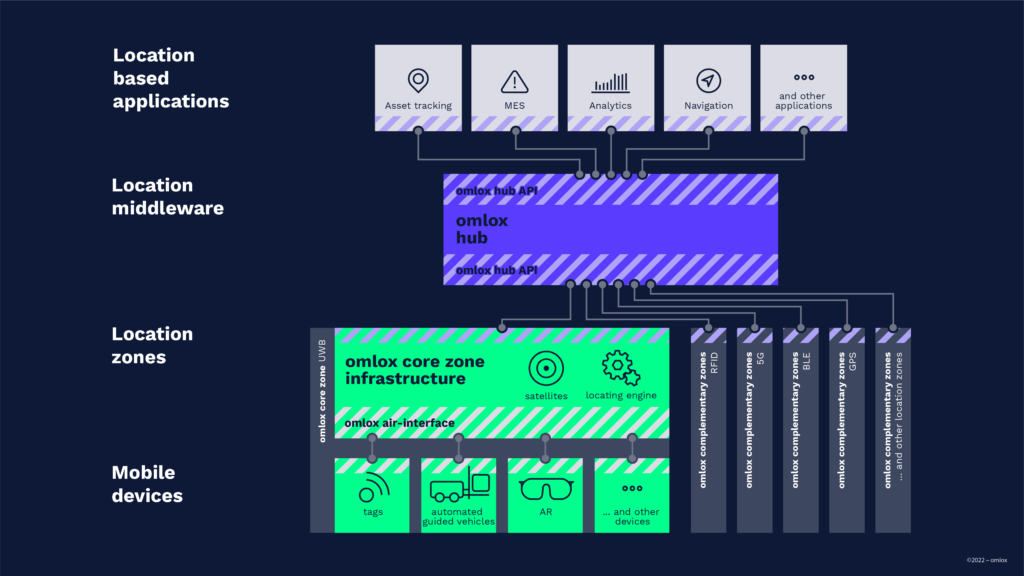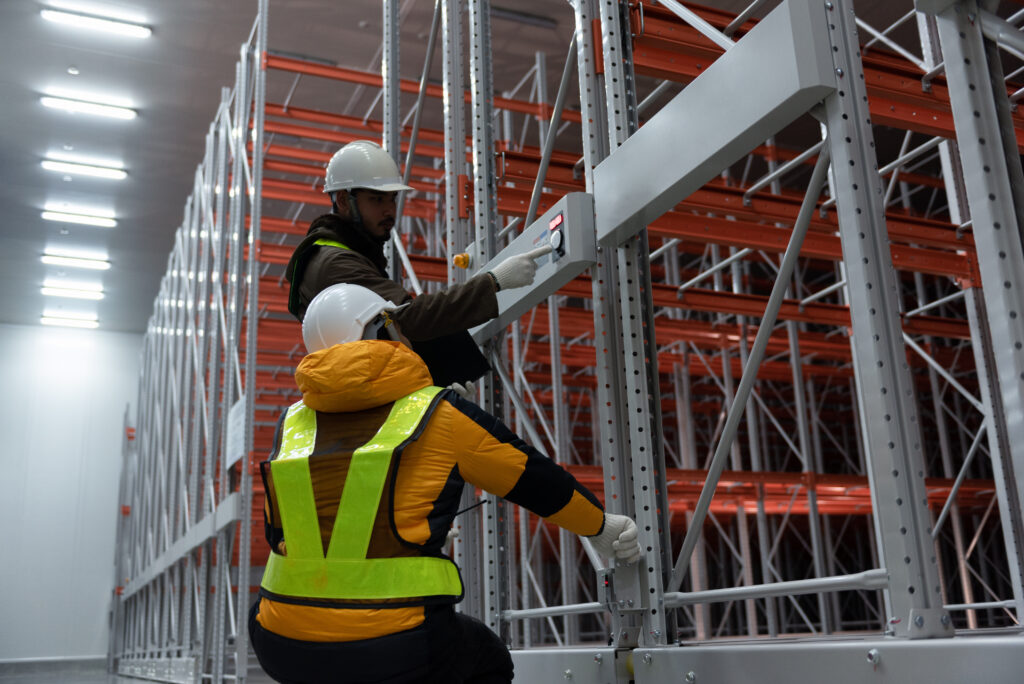Managing and overseeing processes and the movement of assets across supply chains is becoming increasingly crucial to the large-scale success of organizations. A central component is reliable, seamless location data, as it allows businesses to use fewer resources such as time, energy, materials, and costs when used efficiently. This is realized through the adoption of cost-effective RTLS solutions – a combination of hardware (i.e., location sensors/readers, nodes/tags/badges) and software (i.e., location engines, middlewares, applications).
Many different RTLS solutions are available on the market and each has its own benefits and disadvantages in terms of technical and commercial capabilities. However, there is no one-size-fits-all solution for locating technologies, as a single technology cannot satisfy the requirements of all use cases. Until now, available solutions have been proprietary and incompatible with each other due to missing interoperability. This has resulted in high costs and complex integration scenarios.
The obvious conclusion would be that combining locating technologies will reduce Total Cost of Ownership (TCO). Whether a company is currently utilizing a RTLS or is looking to incorporate one into their solution, the ultimate goal should be to use a flexible, modular, and interoperable solution.
omlox & the DeepHub®: Enabling Cost-Effective RTLS Solutions
It is essential for organizations to have a unified view of everything that moves – across all use cases and applications – in order to streamline processes and to operate effectively. However, this often proves to be challenging, given the dynamic and fluid nature of individual system components and processes. This is where omlox and the DeepHub come into play. omlox standardizes both the software and hardware aspects of locating systems, ensuring that RTLSs become suitable for organizations of all sizes.
The omlox standard enables the integration of all locating technologies – irrespective of the vendor – through one standardized API. This interoperability creates an environment for a wide spectrum of use cases and guarantees scalability, flexibility, and cost reduction. omlox is an open standard that thrives from the contributions of its large ecosystem of partners. This ecosystem consists of organizations from various disciplines and specialties, including RTLS providers, hardware and software providers, IT system integrators, and solution providers.
By harnessing a single infrastructure, TCO is significantly reduced across the board, as it allows for easy integration of different applications. The general architecture of omlox consists of two central components:
- omlox hub – a locating middleware that harmonizes location data from different complementary zones. Furthermore, it transforms location data into standardized, global coordinates and provides it to any system or application via the standardized omlox hub API.
- omlox core zone – works in conjunction with open interfaces and guarantees interoperability in the ultra-wideband (UWB) area. Organizations can easily network all UWB products, regardless of the manufacturer.

The DeepHub is the premier omlox hub. It is a lightweight, high performance middleware that can be seamlessly integrated on the edge, in cascading cloud setups, or in hybrid environments. The intuitive UI and extensive REST API simplifies the process of DeepHub integration and the management of zones, geofences, and trackables.
The Costs of RTLS Projects: an Overview of Central Elements
Any project involving a RTLS will incur costs associated with hardware, installation, software integration, and operations. The cost drivers for traditional RTLS projects can be high due to the limited technical scope of RTLS vendors and incompatibility of solutions. omlox provides the base for lowering TCO in and cost-effective RTLS solutions, as it removes these cross-integration barriers. Let’s take a closer look at the different cost components that are applicable in an RTLS project.

Hardware Costs
Consumer products have been increasingly incorporating location technologies in recent years. This trend is particularly true with UWB, as chips have been incorporated into smartphones, automobiles, laptops, wearables, and smart home products. As the prevalence and adoption of UWB continues to rise, more tags and chipsets being produced by different vendors will increase competition and lead to innovation. Thus, UWB chips will become more affordable as demand grows.
Industrial environments strongly benefit from the interoperability and multipurpose nature of an open RTLS infrastructure. As the variety of possible use cases increases, an infrastructure that supports mobile entities from different vendors will ensure a higher ROI. Conversely, a closed, proprietary infrastructure will not easily support and communicate with hardware from different vendors.
Through the omlox hub, this open and interoperable RTLS infrastructure can be provided. The hub allows organizations to embed and combine locating technologies from any vendor. This facilitates the strategic financing of RTLS projects, as organizations can combine highly accurate yet costly RTLS with more cost-effective proximity locating technologies. In the case of brownfield projects, existing locating technologies installed at a facility can be easily integrated through an omlox hub – eliminating the need to start from scratch.
Software Costs
Every solution needs to be integrated individually based on provider specific APIs or customized end-to-end interfaces, which often translates into costly customizations on the application level. In the long run, this results in the need for continuous monitoring and maintenance of the interfaces, especially if changes are done to the locating solution, the business application or the process.
In the past, complex RTLS projects required the integration of several APIs to manage location data – thereby increasing development costs and overhead. When integrating an omlox RTLS solution, the software integration is streamlined by using the omlox hub API. The omlox hub API supports all current and future locating technologies and only needs to be integrated once for custom projects or software applications.
The omlox hub standardizes location data into georeferenced, global coordinates. The hub eliminates the need for data cleanup, since this is performed automatically, and data can be immediately used for analytics and process optimization. Due to the standardization of system behavior, technology providers of different types will behave the same way.
Installation Costs
The goal of a company installing a RTLS in their facility is to ensure that it meets current requirements while also being future-proof. Several considerations can reduce the project’s TCO when implementing an RTLS in a facility. Reducing installation costs can be done in a variety of ways, such as integrating RTLS into existing hardware (e.g., lighting or Wi-Fi). Wiring costs can be further reduced by using a wireless uplink of the omlox core zone (e.g., Wi-Fi6 or 5G).

Operational Costs
Operations and IT costs can be reduced with the omlox hub’s flexible deployment. Depending on the requirements, the omlox hub can run on small edge nodes or in large cloud setups. Customers’ needs can be met with a setup that is adaptable to their IT policies, enabling true data sovereignty.
Since the omlox hub allows for standardization of systems, APIs, and system behavior, the maintenance of the RTLS solution is simplified. The omlox partner ecosystem, which comprises organizations across various disciplines from around the world, makes it possible to implement truly robust and modular RTLS projects.
omlox-compliant products must be certified by an accredited certification center, which guarantees the highest quality of the RTLS as well as continuous development and support.
Conclusion: The Value of Cost-Effective RTLS Solutions
Standardization has always played an important role in industrial automation. With the ability to standardize and homogenize location data, the omlox standard has filled a void and has proven to be an essential ingredient for interoperable, vendor-independent, and cost-effective solutions.
When planning, maintaining, or upgrading an RTLS solution, companies can significantly lower costs by choosing cost-effective RTLS solutions that are flexible and standardized.. The benefits and added-value of the omlox approach describe how a RTLS compatible with omlox significantly lowers costs and streamlines processes. The standardized interfaces ensure a long-lasting RTLS, since any future technologies will be compatible with the omlox standard.
As the premier implementation of an omlox hub, the DeepHub is streamlining RTLS projects in a variety of use cases. Get in touch with us today – let’s tackle your next RTLS project together.
